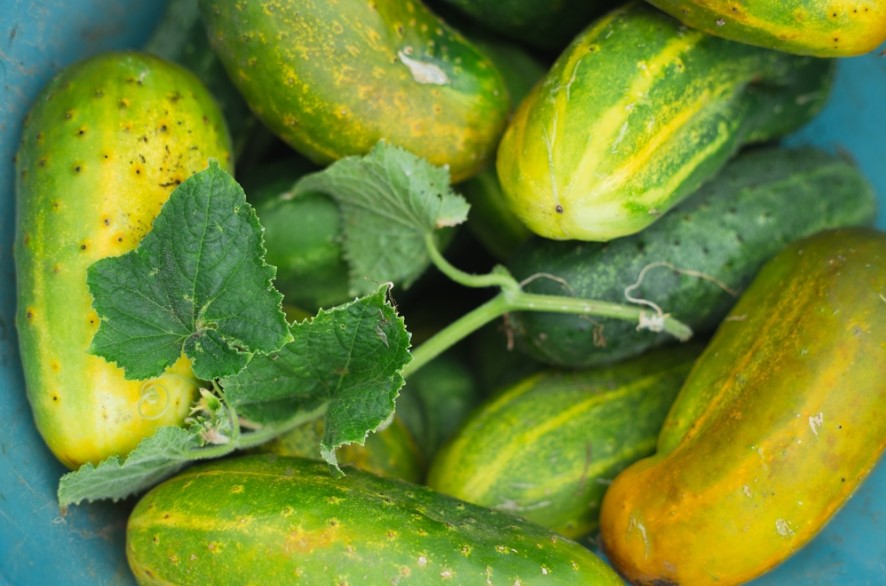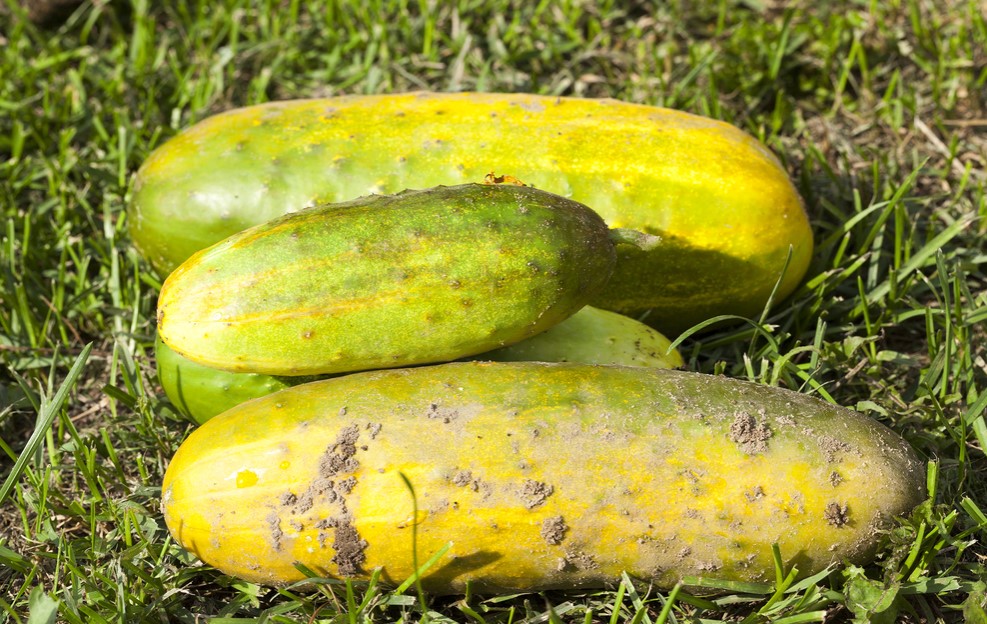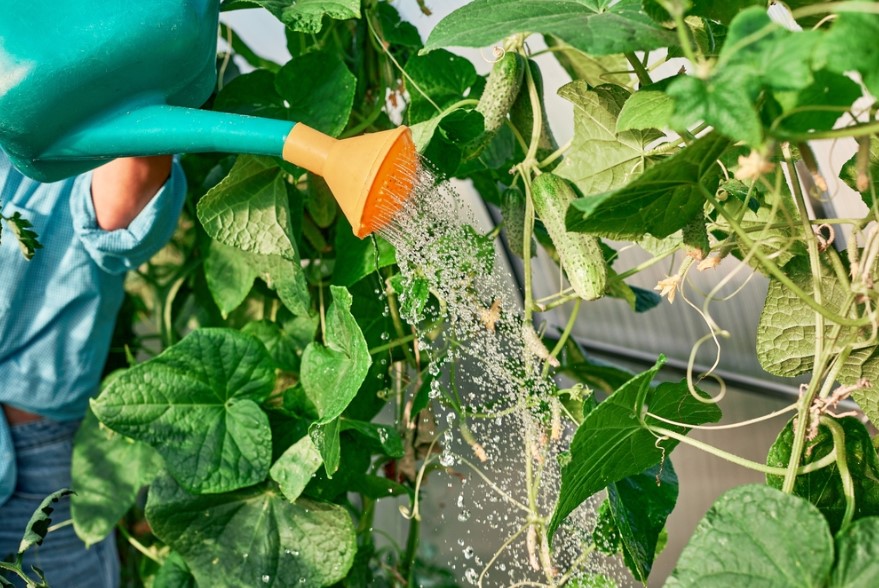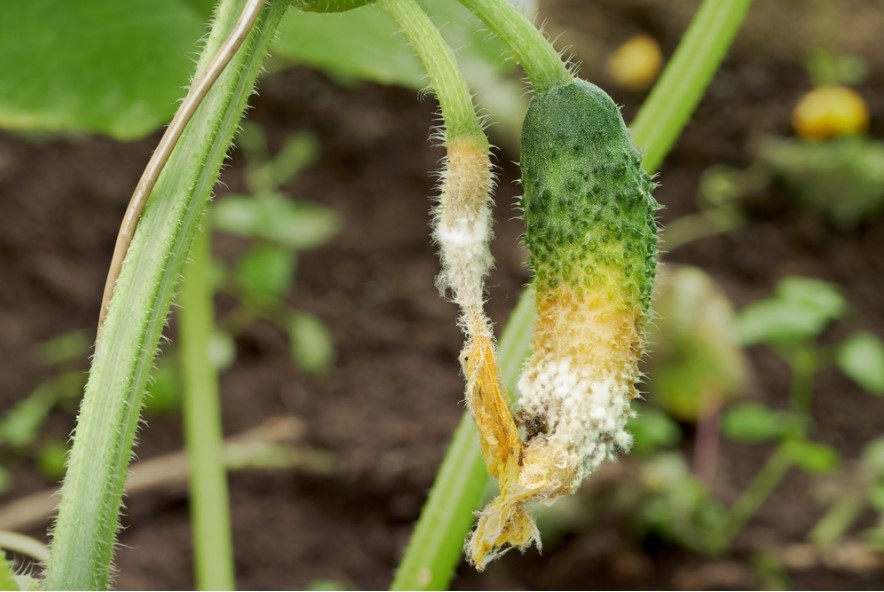Depending on your growing conditions, your cucumbers could be yellowing. This is usually a sign that your plants are water stressed or have an inadequate amount of nutrients. You might be able to solve the problem by increasing the amount of water you provide them, or by applying a nutrient-rich solution.

Why Are My Cucumbers Yellow
Fortunately, there are several ways to prevent cucumbers from turning yellow. These include avoiding overwatering, picking at the right time, and rotating your crops to prevent disease.
The biggest challenge is keeping the vines healthy. Cucumbers require lots of water and lots of nitrogen. These are two of the most important nutrients in the soil. The right balance of these nutrients will help your plants grow healthy and strong.
The right amount of moisture will also help your roots get the water they need to grow. Watering too much will only cause the plant to wilt. The best way to water your plants is to water deeply several times a week.
There are several reasons why cucumbers turn yellow, but the most obvious is a lack of nitrogen. Nitrogen is the main ingredient in chlorophyll, an important component of photosynthesis. Without chlorophyll, your plant will have trouble converting sunlight into sugar.
The best fertilizers for cucumbers are those that have a high NPK ratio, meaning they have three numbers separated by hyphens. The best fertilizers will have an NPK ratio of 10-7-7.
A few of the most important nutrients in the soil are nitrogen, phosphorus, and potassium. You should have plenty of these in your soil to ensure your plants get the nutrients they need.
Poor Soil Quality for Growing Cucumbers
Whether you are growing cucumbers from seeds or transplants, you can help your plants by improving their soil quality. Poor soil conditions will cause a host of problems for your crop.
Cucumbers are a member of the Cucurbitaceae family, which also includes melons, gourds, and zucchini. These plants are sensitive to a variety of diseases. The best way to prevent disease is by choosing disease resistant varieties.
Some of the most common diseases include downy mildew, bacterial wilt, and powdery mildew. These diseases will attack your cucumbers’ foliage and fruit. You can treat them with fungicides or fungicidal soil drenches.
Cucumbers need a rich, nutrient-dense soil to thrive. They also need consistency, even moisture. You may need to water more frequently during hot weather.
You can improve soil quality by adding organic matter to the soil. Mulch helps prevent weeds and conserves moisture. It also discourages cucumber beetle eggs.
Cucumbers respond well to a fertilizer that contains nitrogen. You should add 50 pounds of nitrogen per acre. Follow this with two supplemental top-dressings of fertilizer. Adding compost and coconut coir will also help prevent cucumber root rot.
When planting cucumbers, plant them about six to eight inches deep. Make sure you plant them in soil with a pH of 6.5 to 7.0.
Cucumbers Over-Ripening

Having yellow cucumbers can be a problem. They can be caused by a variety of factors. It’s not always clear what is the cause, but you can take steps to avoid having them turn yellow.
Some of the main causes of cucumbers turning yellow are overripe, a nutrient deficiency, and a disease. When cucumbers turn yellow, they will be bitter and mushy. The best time to harvest your cucumbers is before they are completely ripe.
The best way to prevent cucumbers from turning yellow is to water them deeply several times a week. This will help the roots transport water to the leaves.
If cucumbers are turning yellow, you may need to check the soil to see if you have a mineral deficiency. If you do, you can treat it with a fungicide.
You can also try to cut out the yellow leaves of your cucumbers to prevent the disease from spreading. This can help to prevent the disease from spreading to other cucumber plants.
A plant without leaves will not be able to produce chlorophyll, a key ingredient for photosynthesis. Cucumbers are heavy feeders, and need a lot of nutrients to grow healthy.
It is also possible that the soil is a little too moist. You can use a fingerstick test to check the moisture of the soil. If the moisture is too high, you may need to water more often.
The Plants Are Water-Stressed
Generally, the most common cause of plants turning yellow is moisture stress. This can be caused by over watering, under watering, or by putting too much fertilizer in the pot. If you’re not sure if your plant is getting enough water, you should get your water levels checked regularly.
One other cause is natural aging. The older a plant gets, the more it will show signs of wear and tear, including yellowing leaves. Fortunately, you can remedy this problem by burying citrus rinds or compost at the base of the plant.
There are many other reasons for a plant’s green thumb to turn yellow. The best way to determine if your plant is water stressed is to get a soil test. The results can tell you if your plant needs supplemental nutrients or if it’s getting too much of the good stuff. Adding a small amount of gypsum to your soil can help.
There are many other reasons your plant may be water stressed, such as a dry soil, excessive heat, a lack of humidity, or a combination of all three. A common solution is to move your plant to a partially shaded spot. If your plant doesn’t perform well in direct sunlight, you may want to consider screening it to prevent burning.
The Plants Are Getting Too Much Water

Detecting when the plants are getting too much water and are turning yellow can be a little tricky. However, it is possible to use some simple tools to help you determine the culprit.
A pH meter is one of the best tools for determining the conditions that your plants are experiencing. You can also use apps that help you keep track of your watering schedule.
Leaving your plants in the sun too long is another cause of yellowing leaves. During the warmer months, your plants need to be moved to a shady area. This is important to prevent burning and allow your plants to get adequate light.
Yellow leaves can also indicate a lack of nutrients or poor light. In general, plants are unable to perform photosynthesis in low light.
Luckily, the most common causes of yellowing leaves aren’t serious. However, you might be surprised to find out that some plant problems are quite deadly.
Yellow leaves are caused by a number of factors, including pest infestation, improper lighting, poor soil, or disease. Detecting the best solution for your problem will depend on the specific symptoms.
Yellow leaves can also indicate that you aren’t providing your plant enough water. You may want to consider moving the plant to a larger container that has better drainage.
Nutrient Deficient Vines
Those who are growing cucumbers may notice that they are turning yellow. It is possible that this is caused by nutrient deficiencies in the vines. The best way to avoid cucumber yellowing is to make sure that your plants get the nutrients they need.
Nutrient deficiencies can be caused by a lack of nitrogen or potassium. Both of these nutrients are required for the health of the leaves and the root system.
A nitrogen deficiency will cause the leaves to turn yellow and the stems to wilt. In addition to wilting, the leaves will also lose chlorophyll. When you find yellowing cucumbers, it is best to remove them and treat the vines for nitrogen deficiency.
Similarly, a potassium deficiency will cause yellowing on the older leaves. The fruit of nitrogen deficient plants is pale and misshapen. It is also possible that the fruit fails to develop at the blossom end.
Similarly, calcium deficiencies can cause the fruit to become tasteless. Consequently, the yield will be reduced.
Besides diseases, cucumbers can be a target for aphids and squash vine borer. You can prevent aphid infestations by installing a reflective mulch. Alternatively, you can use a hose to spray the vines and prune them.
The Plants Are Diseased
Using a fancy schmoole to produce a few hundred plants was the only way to go. The bigwigs in the family have a lot of ado about them, but a few hundred tweens, tweens, tweens and the crows haven’t a whole lot of time or inclination to tinker with the sex. The aforementioned tweens are tasked with mowing the lawn, mowing the garden, weeding the flower beds and taking care of the pets. The aforementioned tweens also need to be told what is what and who is what. The aforementioned tweens, tweens, and tweens are all for the most part in the same room, albeit with different coloured glasses. The above mentioned tweens need to be told what is what and who will not get the best of them all.
Lack Of Pollination
Often when cucumbers turn yellow, it is because they lack the appropriate pollination. When there is no pollination, the cucumbers will not form into fruit. Instead, they will fall off the vine.
To attract pollinators, you should plant flowers around the cucumbers. You should also make sure to provide balanced fertilizer. The ideal fertilizer is one that has nitrogen, potassium, and phosphorus. It is also a good idea to rotate crops.
If you have a large garden, you might want to consider growing a trellis to keep the cucumber vines from leaning over. It also might be a good idea to add some compost.
You should also make sure to water the plant regularly. Cucumbers require plenty of moisture to stay healthy. Water should be aimed at the base of the plant, not at the leaves. Watering at the ground level will also stop the spread of diseases.
The best way to determine if your soil has the proper moisture levels is to perform a fingerstick test. This will tell you if you need to add fertilizer or not. You should also consider using floating row covers to deter cucumber beetles.
When it comes to cucumbers, the best fertilizer to use is a balanced one that has NPK levels of 7-5-5. You should also avoid using pesticides. These may be harmful to the garden’s most important pollinators, like bees.
Virus Or Disease Damage To Cucumber Plants

Virus or disease damage to cucumber plants is a common problem that can cause significant losses to the crop. There are several types of viruses that can affect cucumbers. Each type has its own symptoms and can result in damage to the plant.
The cucumber mosaic virus is a virus that affects a wide variety of plants. This virus can cause mottling or mosaic patterns on leaves and fruits. The severity of the infection is dependent on the number of infected plants and aphids that are present.
Another fungal disease that can cause damage to cucumber plants is Alternaria leaf blight. This disease spreads when water splashes on infected plants. If left untreated, alternaria leaf blight can result in brown spots or irregularly shaped areas on cucumber plants.
Another disease that can affect cucumbers is anthracnose. This fungal disease causes sunken, water-soaked spots on cucumber leaves and fruits. If left untreated, anthracnose will kill the cucumber plant.
This disease can affect a wide range of vegetables and can be easily controlled with good garden hygiene. Avoid overhead watering and other methods that may weaken the plant.
If you have anthracnose on your cucumber plant, you should pull the plant up immediately. You can also destroy infected plants by boiling them or hot composting them.
Can You Eat Yellow Cucumbers
Those who love cucumbers will likely be curious about the question, can you eat yellow cucumbers? There are actually two different ways to grow yellow cucumbers: naturally and artificially. The most common reason cucumbers turn yellow is because of lack of nitrogen in the soil.
The best way to prevent cucumber yellowing is to water deeply several times a week. It’s also a good idea to rotate your cucumbers every year. Some of the best fertilizers for cucumbers have an NPK of 10-7-7.
Another reason for cucumber yellowing is powdery mildew. This can hinder photosynthesis and cause thick white powder to form. You can treat powdery mildew with neem oil. You can also cut away the affected leaves.
Another common reason for cucumbers to turn yellow is when they get too much water. This can deplete essential minerals from the soil. This can lead to tough skins and bitter tasting cucumbers.
Yellow cucumbers are also a sign of a pest or disease. It’s important to find out the root of the problem to preserve your cucumber harvest.
If you don’t know the cause of your cucumbers turning yellow, you may have to replant your cucumbers. This can be difficult to do if you don’t have a moisture gauge.
How To Prevent Yellow Cucumbers
Depending on your soil type and nutrient level, you can help prevent yellow cucumbers by incorporating some good growth practices. These practices include crop rotation and using an evenly moist environment. You can also include flowers and other herbs to attract pollinators.
A fungal disease, called powdery mildew, can cause yellow cucumbers. This disease occurs when water splashes onto the leaves when you water your plants. When powdery mildew occurs, the whole plant becomes yellow and the chlorophyll in the leaves is weakened. You can treat the disease by applying neem oil early in the season.
Another fungal disease that can cause yellow cucumbers is leaf spot. This disease is caused by several different fungal diseases. If your leaves have a spot, you should prune them to reduce the chances of the disease spreading.
Another fungal disease that can cause leaf spot is bacterial wilt. This disease is spread by cucumber beetles. If your cucumbers begin to show signs of bacterial wilt, you will see wilting leaves, browning leaves, and yellowing fruits.
Using a row cover on your cucumber vines can also reduce the chances of bacterial wilt. This netting should be removed when your plants are ready to flower.
What To Do With Yellow Cucumbers
Whether you are growing cucumbers as an annual or a perennial, you’ll need to know what to do with yellow cucumbers to ensure their continued health. Yellow cucumbers can be a sign of a disease, pest, or nutrient deficiency.
The best way to prevent yellow cucumbers is to water them deeply several times a week. You can use a moisture gauge to check the moisture level in the soil. Aside from watering, cucumbers need a lot of sunlight. You can also install hummingbird feeders and bee boxes to attract pollinators.
You can also treat powdery mildew on your cucumbers with neem oil. Neem oil is effective in treating the disease when it’s early on. You can also apply slow-release granules monthly.
To combat diseases, you can grow resistant varieties of cucumbers. These include Diva, Burpee Hybrid II, and Thunder. Also, make sure you don’t use conventional fertilizers that may contaminate groundwater. Organic fertilizers are better, as they don’t add toxic chemicals. You can also plant flowers and herb plants to attract pollinators.
Cucumbers are heavy feeders, and they need plenty of nutrients to grow well. A healthy, well-balanced fertilizer has nitrogen, phosphorus, and potassium in the right proportions.
Conclusion
Fortunately, you can prevent cucumbers from turning yellow. But if the plants already have yellowing leaves, you may need to add some nutrients. Adding compost or manure is a good way to do this. You can also apply insecticidal soap to eliminate cucumber pests.
Overwatering can also cause cucumbers to turn yellow. It is important to water deeply several times a week. Watering deeply helps the roots to soak up water. This also helps the roots to get the oxygen they need. It also allows the roots to transport the water to the leaves.
Another cause of cucumbers turning yellow is a nitrogen deficiency. Adding ammonium nitrate can fix this problem. It is best to use a balanced fertilizer that has a 10-10-10 ratio.
Potassium deficiency can also cause cucumbers to turn yellow. This can result in leaf puckering and poor fruit development. Adding potassium to the soil can also help prevent this problem.
If your cucumbers are starting to turn yellow, it is possible that they are suffering from downy mildew. This disease is caused by six species of Verticillium fungi. The leaves of the plants become yellow and then develop a gray mold underneath. You may also notice yellow spots that turn brown later. It is important to stop the progression of this disease. You can use fungicides to prevent the disease from spreading.
